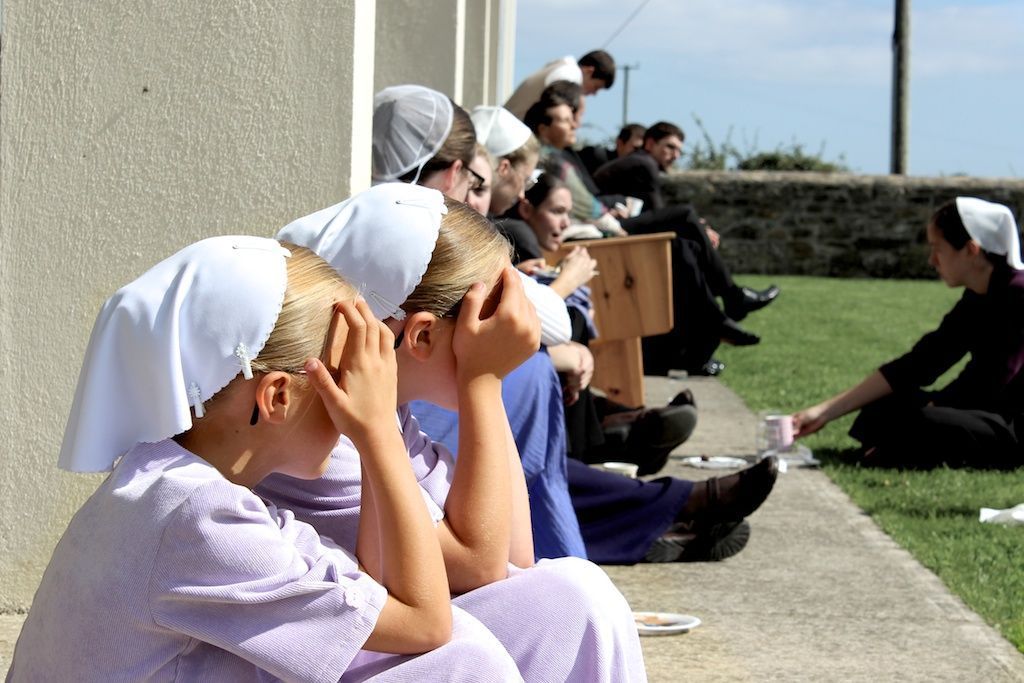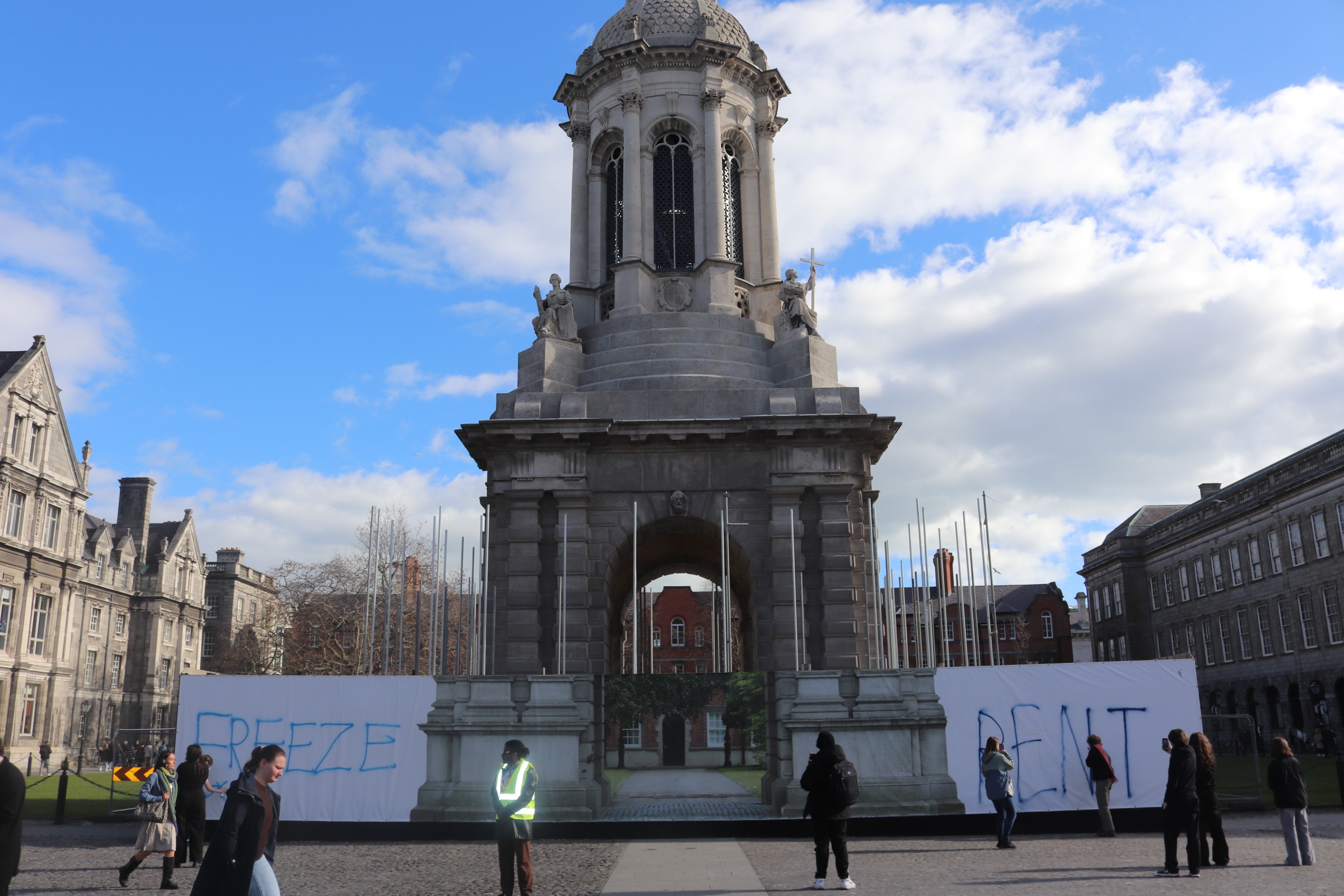Rachel Lavin | Magazine Editor
Tucked away in the hillside of Dunmore East in Waterford is a little known community called ‘The Christian Fellowship’. Comprised of little more than a shop, a church, a school and a collection of modest bungalows passers-by may be unaware, only for the sight of the trademark veiled woman or a bearded man in old-fashioned clothing, that they are in fact, passing through Ireland’s only Amish community.
Normally relatively closed off from the modern world and reluctant to interact with the media, I am grateful for the chance to be joining them for their monthly Sunday celebration in which the entire community of 75 comes together for a day of activities. It begins, unsurprisingly, with mass. We pull up outside the local center which functions as a church, school and dining hall just in time for the 10.30 services. Outside families are entering the hall with their children all dressed in the traditional Amish dress; full-length dresses and cardigans, white veils pinned to cleanly pinned hair and bearded men in crisp white and black shirts and waistcoats. I feel as though I’ve stepped into an episode of little house on the prairie.
The only clue that I am an outsider is the little girl sitting who proceeds to turn and stare at me for the majority of the service.
My photographer Ben and I are welcomed warmly by the leading Pastor, Daniel Yoder and are quickly shown to the main hall for the service which is about to begin. I am ushered to the women’s side of the church and am met with a sea of smiles and welcomes amongst the rows of white veils. The only clue that I am in anyways an outsider is the little girl sitting in front of me, who dressed in a lavender home-made dress, glasses and a veil pinned over a neat bun in her hair, proceeds to turn and stare at me for the majority of the service, suspiciously eyeing up every detail, from my unruly curly hair to my thick black glasses, my bright patterned scarf, then my chipped nail varnish to my scuffed black boots. Least to say, she doesn’t look incredibly impressed.
We begin the sermon, as directed by the pastor with a series of hymns. I am handed a thick hymn book of over 500 hymns and, on the suggestions of the congregation they go through about five hymns picked at random, all in perfect harmony. Their singing is as angelic as it is complex, with not a bum note in earshot. I decide to lip sync.
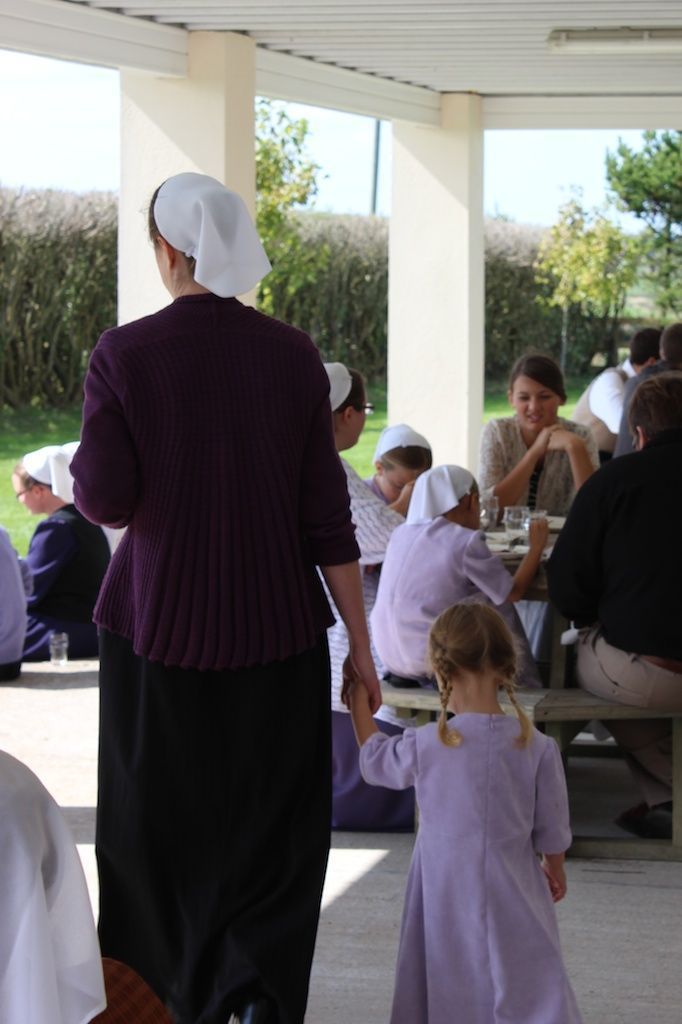
The pastor begins with a short service and then everyone rises for bible study. The children and women move to separate rooms, where we sit around in a circle and introduce ourselves. There are about fifteen Amish women and all but one have American accents. (she is South American). They begin with offers to testify. There are some suggestions for relations teaching in a settlement in Ukraine, a prayer for Susan, who is heading back to her own home settlement in America after two years and an offer to bulk order some oats from the North if anyone wants some.
She deduces from our biblical reading that ‘we are not to follow earthly beings or worldly goods, but to follow God and his message only’.
We then begin the bible study class and between reading sections and analysing them as we go I can’t help but feel as though I’m back in an English literature tutorial, such is the steadfastness and concentration with which the women read and interpret the passage. Lead by an older woman with a kind softly-spoken voice, she deduces from our passage ‘that we are not to follow earthly beings or worldly goods, but to follow God and his message only’. The others nod in agreement and although I was skeptical as to what new I could learn at bible study, this little snippet provided me with an interesting context for the rest of the day.
We return to the service at the same time as the children and rejoin the men who were taking their bible study in the main church and begin another part of the service, this time lead by a visiting American pastor. After a final round of hymns we break. The women begin to hastily begin to prepare lunch; a large potluck dinner for the whole congregation, and the men lay out large tables in the back end of the hall.
A warm motherly figure named Barbara approaches me to welcome me and invite me to eat. A generous buffet has been laid out and after struggling with what to select, I settle on a plateful of meatballs and rice dishes, meat casseroles and spiced pickles and vegetables, and we sit and tuck in. Barbara’s husband Pastor Dan joins us. A softly spoken and contemplative man, he is one of the original members of the Amish community which was was founded little more than twenty years ago. It was lead by William McGrath, an ex-army intelligence officer who had converted to the Mennonite religion after a crisis of faith during World War two. He went on to travel widely, setting up Mennonite churches all over the world, including Costa Rica, Germany and Switzerland, but his pet project was to bring a Mennonite church to his ancestor’s homeland, and that he finally did in setting up ‘The Christian Fellowship’ in Waterford in 1992.
They found themselves renting in the city, a far cry from where they grew up in the rural Amish towns of AppleCreek in Maryland.
However, William needed to populate this select community in a ‘land of strangers’. Pastor Dan who grew up Amish, came to the Amish-Mennonite settlement with his wife Barbara in 1996 for one simple reason, ‘I was asked’. Knowing they were needed the couple moved over, but with no official community centre or even community of houses for them to live in, they found themselves renting in the city, a far cry from where they grew up in the rural Amish towns of AppleCreek in Maryland.
This was a ‘huge change’ Dan recalls. “I had always lived in the country and now I was living in a housing estate. Young people used to drink outside, it was very difficult. It took us three years to find a house’.
As more families emigrated over they moved into more houses in the same area and the community developed, eventually making a small local rural area in Dunmore East their own.
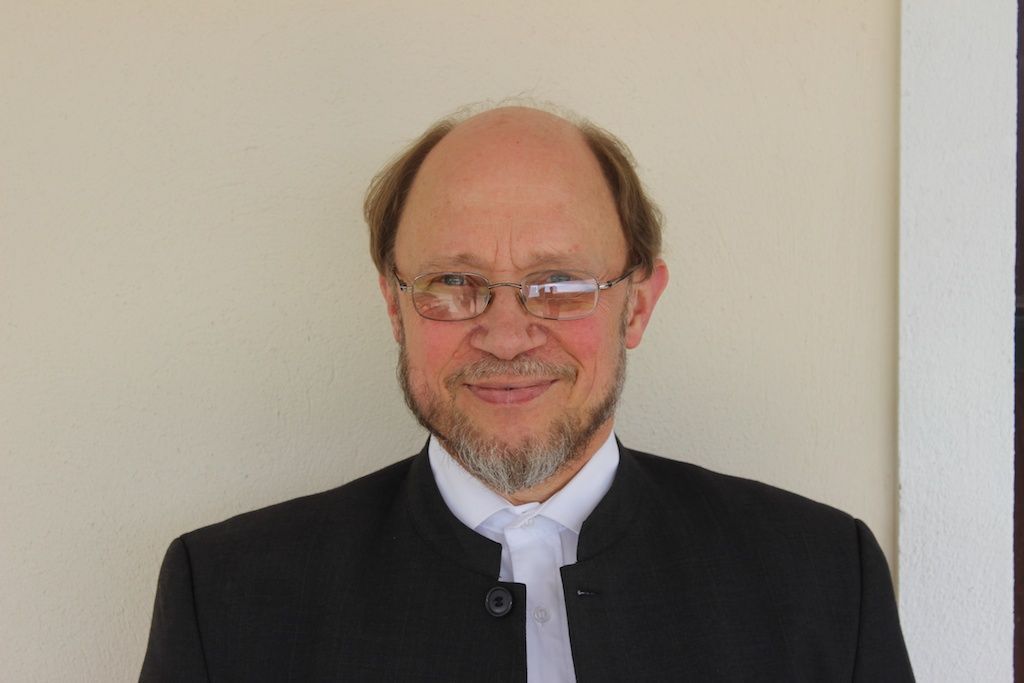
Since finding their feet in Dunmore East the community is now firmly established as Ireland’s first Amish-Mennonite community made up of roughly 75 people. The community is made up of Amish and Mennonites from mainly America, Poland and Ukraine. There is also one newly Amish Welsh family, who converted to the Mennonite way after becoming increasingly exasperated with the Anglican church.
Here, the men and women follow traditional roles with the women primarily working as care-givers and homemakers while the men work mostly in blue collar jobs such as carpenters, blacksmiths, plumbers and shopkeepers. Although men are the main breadwinners, Dan explains the men try to do flexible jobs that allow them to stay at home as much as possible with their family. One of the community’s main sources of income is a co-operative business they set up near their homes, which includes a grocery shop, a bakery, a book shop and a wooden furniture store.
“In the aftermath of a bereavement, locals will tell of how a group of the Amish will turn up to their house and wash their windows.
‘The shop helps us to get to know the people.’ Says Dan’s wife Barbara. ‘This way they know we are not hidden behind cloister walls’.
Indeed, the public are welcome to attend their weekly mass and are invited to ‘come as you are’ and, from speaking to friends in Waterford beforehand, it appears that they are a well respected and liked group. Of course their famed baking sold through the shop, especially the granola and carrot cake, has helped. The Amish are also famed for what they do whenever a local death occurs. In the aftermath of a bereavement, locals will tell of how a group from the community will turn up to their house and wash their windows and clean their gardens, completely unasked. This practical assistance in times of need has warmed this otherwise foreign outpost to the hearts of the locals and earned them a strong respect in the nearby communities.
But while the Amish are open to interacting with the local community and having them join them for their religious and social celebrations, they will not compromise their own values or ways in order to become involved in the community. Instead they keep a careful distance, observing the modern world from afar. For example, Dan explains they will keep politically aware but, as the Mennonites are pacifists, they will not vote. Similarly, while they observe local laws they do not make use of them personally. For internal disputes Dan admits that ‘we tend to settle it ourselves as we would be reluctant to go to the legal system. We may try to resolve it ourselves and then ask for U.S. or other Mennonite communities to come in as mediators and counsellors. Thankfully though this doesn’t happen very often’ When it comes to outsiders committing a crime upon them, even then Dan admits they don’t press charges. Unfortunately however, their peaceful nature has been the subject of several robberies in their local shop. Dan explains that in that case ‘we go to the local Gardai but we see these crimes as a moral or spiritual problem. Even with outsiders, we don’t involve the law in trying to put them in jail or for legal justice, but more to help that person.’ As a younger man, Wendall, explains ‘we don’t see it as our job to do justice. That’s God’s job.’ Dan explains ‘We would not press charges and, failing that, we would let the law take its course but seek restorative justice.’
I am more than a little surprised to see the pastor opening his laptop mid-sermon, connecting it to a projector and preceding to give a PowerPoint presentation on ‘grace’.
As well as operating under their own framework of what is just, the Amish are perhaps most famed for living without modern technology. Pastor Dan, who grew up Amish, admits that the devout Amish ‘live a hard life with no electricity or phone’ but that in the Waterford Amish Mennonite settlement, which is more liberal in its belief system,‘we have more modern conveniences’. Indeed, the extent of how much they shun the applications of the modern world was initially confusing to me. I had specifically avoided bringing my laptop to take notes given my assumptions about the Amish being anti-technology so am more than a little surprised to see the pastor opening his laptop mid-sermon, connecting it to a projector and preceding to give a PowerPoint presentation on ‘grace’. This happens at multiple times throughout the day, where an i-pad is whipped out to show children a photo during story-time or a laptop is gathered around to show photos of friends abroad.
Here, Dan explains, the members do have cars, and live in modest bungalows. They read newspapers, listen to music on C.D. players and use the internet and phones. But their use of these modern appliances is done with a studied carefulness. Their use is limited to their role in their spiritual goals. They use newspapers to keep aware of modern world affairs but take no interest in politics or modern culture. They use communications, but mainly to stay in contact with other Amish-Mennonite communities and daily conveniences.
‘We are not just a back to earth community, nor do we live this way because of the quaint lifestyle it evokes. Rather it is a spiritual motivation’.
Barbara explains that, ‘with each new technology coming out we question if we need it or not, if it furthers our cause and adheres to our morals’. Dan continues saying ‘We are not just a back to earth community, nor do we live this way because of the quaint lifestyle it evokes. Rather it is a spiritual motivation’. As long as the modern technology does not interfere with their spiritual goals then they will decide to absorb it into their lifestyle. Strict control however is asserted when using the modern inventions in this way. The Waterford Amish shun T.V. and radio but will watch selected films or play C.D.’s. This is because, as Dan explains,‘this way you choose what you are exposed to’. What they are avoiding is modern popular culture, something they consider full of sinful distractions and unnecessary frivolities.
This pointed modesty is reflected in their clothing. Dan who is wearing a closed collar black suit, much like the Beatles wore in the sixties, and a white shirt with no tie, explains ‘I don’t wear neck ties, as what’s the purpose? I don’t see the value and so choose a closed collar’.
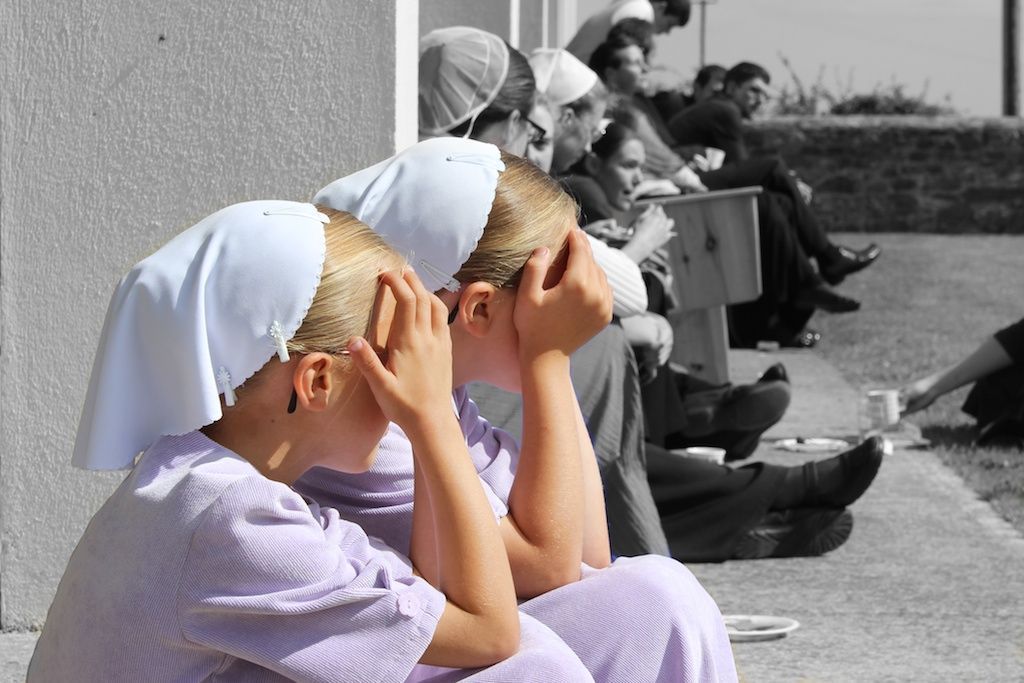
When I ask Barbara about the trademark veils and modest dress of the Amish women, she explains that this is for one of two reasons. ‘The veils are scriptural, as the bible talks about women being covered and our goal is to be as close to biblical as we can. They symbolise the submission to the head, that is both Jesus and our husbands, a view I know is not popular in the modern world.But for us modestly is a high priority. It is also because of the angels’ she adds, ‘Without the veil it opens us up to sinful influences. Without it we wouldn’t feel right, it offers us spiritual protection’.
In relation to her homemade dress, Barbara explains they are ‘trying to be practical’ It is important to cover the body and not to reveal. She continues ‘Most fashion is to attract attention but we believe that is wrong from a moral aspect as it encourages vanity and (clothes are) for modesty.’
‘Without the veil, we wouldn’t feel right. It offers us spiritual protection’
In determining the value of any cultural norm, they first question, ‘what is the end goal?’ As Dan explains ‘Our goal is to be pleasing to God. The Grace of God teaches us how to live modestly and with purpose. Not just to live for the pleasure of the senses or to do what feels good at the moment. There is no lasting value there, it destroys rather than builds.’
Abstaining from modern hedonism seems to be one of their core ideals and is made easy within a community of like-minded people. But outside the community, the vices are boundless. Dan admits that when the youth are leaving for study or travel that ‘it’s a challenge and a big change when they’re away from home. They don’t do that carelessly though. For example Richard, a young man who is moving to England that week to do an apprenticeship as a blacksmith, is going to live with the Mennonite family near his college, what Dan calls a ‘safe environment’. Otherwise, he explains ‘We would be reluctant to have him going to Dublin if there was no regular contact with a Mennonite family.’
When I ask about those who choose to leave the Amish way completely Dan admits ‘Most choose to stay but not necessarily everyone. It is naturally difficult. Thankfully we have six so far (referring to his own children) and all have chosen to stay in the church.’ Were they to leave however he says ‘we would generally maintain quite close contact, but I suppose it is individual to each family. Most stay on friendly terms’.
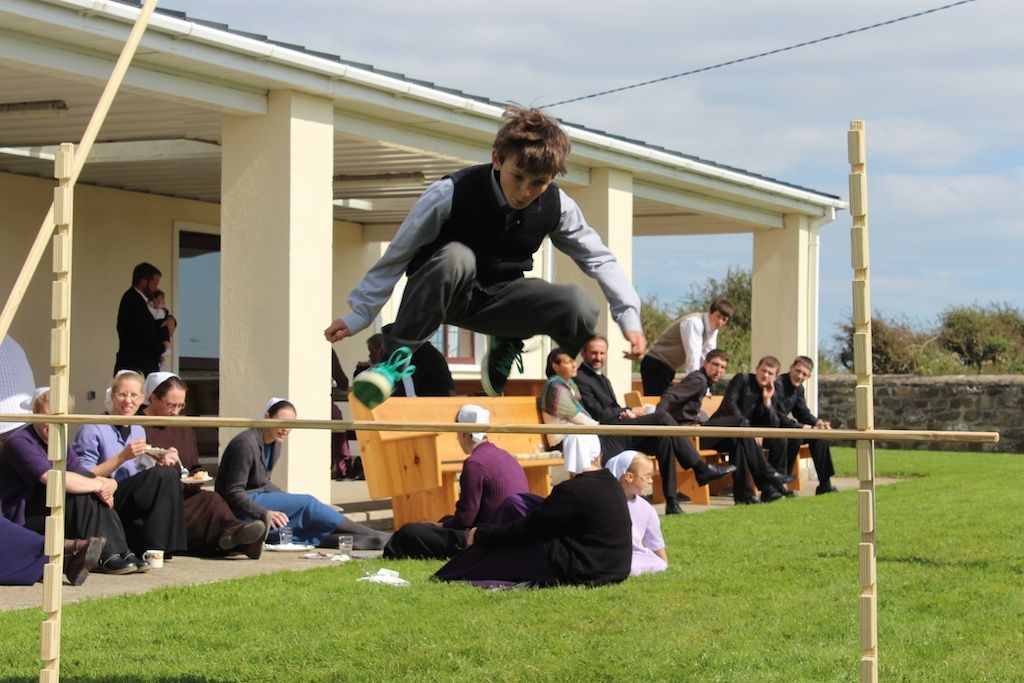
We are suddenly alerted to the fact that both Dan and I are the last two in the hall still eating, as we had been so deep in conversation. The rest of the community have moved outside and are enjoying their desserts in the last of the summer sun. Talking and laughing quietly they watch the children, who, ranging from as young as three or four to ten or twelve, are making a great lot of use of three wooden sticks. Between limbos and high jumps they constantly restructure them, inventing new ways to play. There seems to be no limit to the level they could amuse themselves with just these three wooden sticks. There is a great sense of calm here and it seems the biggest concern of the members for the rest of the day is enjoying good food, the warm weather and each other’s company in this small rural community.
As separated as they are from the modern world, the community does seek to give something back to their new homeland in terms of civic duty. Outside I meet with Wendall, a young enthusiastic man in his thirties who tells me about Camp Comeragh which he is setting up with the help of the local community in the nearby village of Rathcormack. These wilderness camps are based on an American model that aims to help anti-social and troubled youths. Having gotten the HSE and social services on board, the camp takes private placements of troubled youths from struggling families and, run by specially trained members of the Dunmore East communities, they aim to help young boys through anti-social behaviour and personal problems by setting them up to live independently in the wilderness for six week periods over the course of a year.
By stripping back society to the basics, hypothetically, at least, the camps do make sense. And who better to teach the basic components of a good living than the Amish?
Once admitted, with the permission of the parents and co-operation of the boy, the lads will be set up in the forest with little more than two self-constructed huts they build up themselves and with two male councillors for daily guidance and counselling.. They will be living in a group of lads with similar problems and in a highly intense framework will be taught the basics of problem-solving and co-operating, goal setting and personal organisation. Meals are made five days a week in a dining cabin by a cook but for two days each week the boys much plan their own meal and fend for themselves, cooking their meals over a fire. So far two have completed the course in full and three are currently in the program. Families will also be involved in the counselling progress and Wendall is hoping he can expand the program in future. He says that in America the programs have seen an 80% success rate I improving the lives of troubled youths and he admits he sees a change in the three boys he is working with now. I propose it is perhaps a bit extreme but Wendall believes it is a setting that limits distractions and allows them to solve problems in an intensive setting, teaching them both them how to be independent while at the same time learning the value of dependence. Wendall stresses the camps although are ran by the Mennonites are not trying to convert the boys in their care. He says ‘The camps have a simple approach. It is not tremendously technical. Our goal is to equip the boy with the goals to tackle the challenges of daily life. That model then enables them to go and share’.
By stripping back society and highlighting the importance self-reliance, the benefits of social dependence and survival through goal-setting and problem-solving in order to correct a person’s anti-social behavior, hypothetically at least the camps do make sense. And if that is the case, who better to teach the basic components of a good living than the Amish? Away from all the complications and distractions of modern life, both worlds offer serious space for introspection and an evaluation of the basic values at play in our day-to-day lives. Both bring society down to its basic practical level, that of survival, interdependence and the moral values they as a community seek to uphold.
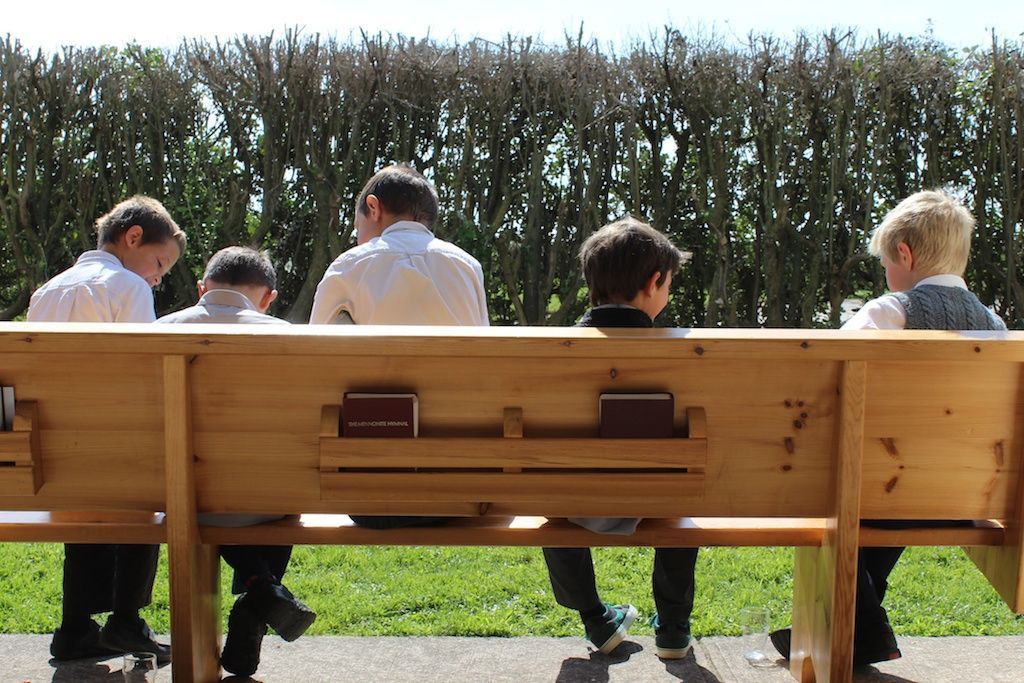
For the final part of the Sunday celebrations, we move indoors for the entertainment section of the evening. We begin with several rounds of hymns, a story telling for the children which brings much innocent laughs and the young men and women sing an array of songs that are still religious at their core but what the leading guy, probably around my age, calls ‘something fun and different’ but it sounds very similar to me. Apparently musical instruments are banned so relying to the pure grace of their voices they offer us the full capabilities of their vocal range.
Their spiritual goals are their driving force. Meanwhile, the modern world and passing times and cultural trends, inventions and technologies are mere blips on their radar.
During their songs I notice a timeline that is placed on the wall, looping the entire room. On closer inspection it outlines a series of world political and cultural events with everything from when A. A. Milne wrote Winnie the Pooh to the fall of the Berlin Wall. All these are mere flicks along a thick black line that flows from Adam and Eve to the establishment of the Mennonites in Europe, their eventual escape from persecution to America and their current return, with the founding of Dunmore East proudly marked along it. Apparently it was a school project they forgot to take down and is the only thing other than a wooden crucifix that adorns the church hall. It seems however that the timeline is an adequate reflection on life here in the Amish Mennonite world. Their spiritual goals, beginning with the bible are their driving force and the central goal, which they live for, symbolised in that continuous thick black line. Meanwhile, the modern world and passing times and cultural trends, inventions and technologies are just tiny blips on their radar. Life here is much the same as it was 500 years ago when the Mennonites began their new way of life. There is something soothing in that. They may not have the adventure of changing times but they do not have the burden either. Whether you believe in it or not, to see a group of people so committed to one way of life, so unconcerned with the trends and changes of our time really brings into question the generational trends and cultural changes we take on to value so easily. Young people today seem to pick and choose morals and lifestyles from a variety of cultures and religions but seem more lost than ever. Hedonism, narcissism and materialism are such a key part of our modern lives but are they making us happy? By the time I’m ready to leave, Dan’s words ‘what is the practical purpose, what is the end goal?’ are ringing in my ear.
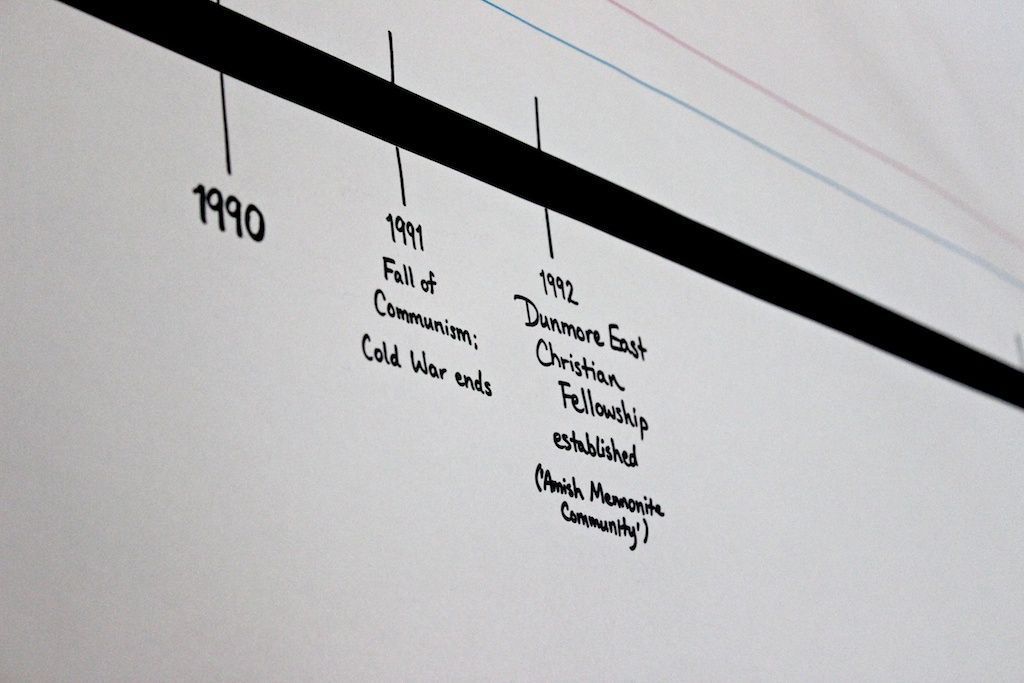
We finish the day with some final few hymns, or what for me is further lip syncing and then the crowd gradually start to clear up and get ready for home. Taking this as my que to leave I gather my things and say my thanks. At the door I bump into Rachel, a girl about my age and out of pure curiosity quiz her on the depth of her knowledge on certain current events and pop culture. Do you know who Barack Obama is? Yes. Enda Kenny? Yes Facebook ? Yes, some members even have it. How about selfies? Yes but she’s never taken one. Hmm I see my lift pulling up so try to think of the most arbitrary thing my generation universally knows of. Just as she turns to leave, I settle on the perfect example.
Kim Kardashian?
Rachel turns innocently and says ‘Oh I’m sorry, I don’t really know much about Irish history and legends’ and saying her goodbyes rushes off back to a world where Kim Kardashian could well have been Cuchulainn’s girlfriend for all she cares.
Perhaps I wonder as I leave the Amish settlement behind, in some senses they may be better off after all.
Photography by Benedict Shegog, Photography & Illustrations editor
